| Article ID | Journal | Published Year | Pages | File Type |
|---|---|---|---|---|
| 5782215 | Marine and Petroleum Geology | 2017 | 42 Pages |
Abstract
Fractures not only control the distribution of oil and gas reservoirs, but also are key points in the research of oil and gas reservoir development programmes. The tectonic fractures in the Lower Cambrian shale reservoirs in the Feng'gang No. 3 block are effective reservoir spaces for hydrocarbon accumulation, and these fractures are controlled by palaeotectonic stress fields. Therefore, quantitatively predicting the development and distribution of tectonic fractures in the Lower Cambrian shale reservoir is important for the exploration and exploitation of shale gas in the Feng'gang No. 3 block. In the present study, a reasonable geological, mechanical and mathematical model of the study area was established based on the faults systems interpreted from seismic data, fracture characteristics from drilling data, uniaxial and triaxial compression tests and experiments on the acoustic emissions (AE) of rocks. Then, a three-dimensional (3-D) finite element method is applied to simulate the palaeotectonic stress field with the superposition of the Yanshan and Himalayan movements and used to predict the fracture distribution. The simulation results indicate that the maximum principal stress value within the study area ranged from 269.97Â MPa to 281.18Â MPa, the minimum principal stress ranged from 58.29Â MPa to 79.64Â MPa, and the shear stress value ranged from 91.05Â MPa to 106.21Â MPa. The palaeotectonic stress field is controlled by the fault zone locations. The fracture development zones are mainly controlled by the tectonic stress fields and are located around the faults, at the end of the fault zones, at the inflection point and at the intersection of the fault zones.
Related Topics
Physical Sciences and Engineering
Earth and Planetary Sciences
Economic Geology
Authors
Zhonghu Wu, Yujun Zuo, Shanyong Wang, Jun Chen, Anli Wang, Leilei Liu, Yunfei Xu, Jibin Sunwen, Juncai Cao, Meilu Yu, Chongyang Lu, Yaowen Wu,
